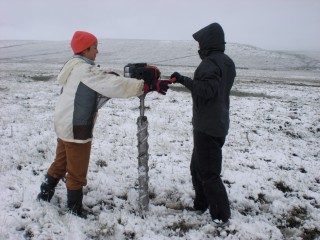Integrated ocean drilling projects

WA-OIG is also involved in a variety of already completed and scheduled International Ocean Drilling Programs (IODP) through the Australian-New Zealand IODP Consortium (ANZIC). As part of a recently funded project we have started analysing the presence of microbial populations based on metagenomic data, lipid biomarkers and stable isotope geochemistry to provide clues about the environmental conditions associated with the formation of Jurassic to lower Cretaceous sediments of the petroleum-rich Northern Carnarvon Basin. Moreover, in collaboration with the Japanese Agency for Marine-Earth Science and Technology (JAMSTEC) we will present a IODP proposal to obtain a 3500 metre-long and 100 million-year-old sediment record at the Lord Howe Rise.
Understanding the tectonic and paleogeographic evolution of this unexplored large underwater continent located between Australia and New Zealand is one of the key goals of this project. But in the likely event that the proposal will be funded, these samples will also provide an opportunity for WA-OIG to study ocean chemistry changes at high southern latitudes from the Cretaceous onwards, and potentially extend the known limits to life beneath the ocean floor. In addition, we will be able to test fundamental evolutionary concepts of sub-seafloor microbial life over a 100 million year timeframe. By way of another example, we will be involved in coring 600 meters into the Chicxulub impact crater off the Mexican Yucatan coast in mid 2016. This is the largest impact crater on Earth and currently, the only one firmly associated with a mass extinction event (i.e. causing the extinction of dinosaurs).
In collaboration with the Department of Applied Geology & John de Laeter Centre, we will combine geological, biological and geochemical techniques to study (1) the duration of the hydrothermal system associated with the impact and its benefit for life colonisation, (2) to what extent the diversity of presumably slowly evolving bacteria in the deep biosphere reflect post-impact environmental changes, (3) the developmental history of planktonic taxa in the post-impact oceanic basin and terrestrial vegetation in the coastal hinterland, (4) and the environmental factors associated with the post-impact ecosystem responses. Additional upcoming IODP cruise in which we will be involved include the Zenith Plateau and The Great Australian Bight.
Examples of publications
Grice K., Gibbison, R., Atkinson, J.E., Eckardt, C.B., Schwark, L., Maxwell, J.R. 1996. 1H-pyrrole-2,5,-diones (maleimides of anoxygenic photosynthesis in paleowater columns. Geochimica et Cosmochimica Acta 60 3913-3924.
Grice, K., Cao, C., Love, G.D., Bottcher, M.E., Twitchett, R.J., Grosjean, E., Summons, R.E., Turgeon, S., Dunning, W.J., Yin, Y. 2005. Photic zone euxinia during the Permian-Triassic Superanoxic event. Science 307, 706-709.
Grice, K., Backhouse, J., Alexander R., Marshall, N., Logan, G.A. 2005 Correlating terrestrial signatures from biomarker distributions, ?13C , and palynology in fluvio-deltaic deposits from NW Australia (Triassic-Jurassic).Organic Geochemistry 36, 1347-1358.
Grice, K., Nabbefeld, B., Maslen, E. 2007. Source and Significance of Selected Polycyclic Aromatic Hydrocarbons in Sediments (Hovea-3 well, Perth Basin, Western Australia) Spanning the Permian-Triassic Boundary. Organic Geochemistry 38, 1795-1803.
Grice, K., Lu, H., Atahan, P., Hallmann, C., Asif, M., Greenwood, P.F., Tulipani, S., Maslen, E., Williford, K.H., and Dodson, J. 2009. New insights into the origin of perlyene in geological samples Geochimica et Cosmochimica Acta 73, 6531-6543.
Jaraula, C.M.B, Grice, K., Twitchett, R.,J., Böttcher, M.E., Le Metayer, P., Dastidar, A.G., Opazo, L.F. 2013. Elevated pCO2 leading to Late triassic extinction, persistent photic zone euxinia, and rising sea levels Geology 41, 955-958.
Naeher. S. and Grice, K., 2015. Novel 1H-Pyrrole-2,5-dione (maleimide) proxies for the assessment of persistent photic zone euxinia. Chemical Geology 404, 100-109.
Thomas, B.M., Willink, R.J., Grice, K., Twitchett, R.J., Purcell, R.R., Archbold, N.W., George, A.D., Tye, S., Alexander, R., Foster, C.B., Barber, C.J. 2004. Unique marine Permian/Triassic boundary section from Western Australia. Australian Journal of Earth Sciences. 51, 423-430.
Tulipani, S., Grice, K., Greenwood, P.F., Schwark, L., Summons, R.E., Böttcher, M.E., Foster, C.B., 2015. Molecular proxies as indicators of freshwater incursion-driven salinity stratification. Chemical Geology 409, 61-68.
Tulipani, S., Grice, K., Greenwood, P.F, Haines, P., Sauer, P., Schimmelmann, A., Summons, R.E., Foster, C.B. Böttcher, M.E., Playton, T., and Schwark, L. 2015. Changes in palaeoenvironmental conditions in Late Devonian Reef systems from the Canning Basin, WA: A biomarker and stable isotope approach. Gondwana Research, in press.
